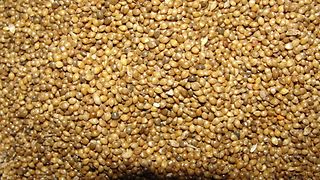
Millets are a highly varied group of small-seeded grasses, widely grown around the world as cereal crops or grains for fodder and human food. Most millets belong to the tribe Paniceae.

Panicum miliaceum is a grain crop with many common names, including proso millet, broomcorn millet, common millet, hog millet, Kashfi millet, red millet, and white millet. Archaeobotanical evidence suggests millet was first domesticated about 10,000 BP in Northern China. Major cultivated areas include Northern China, Himachal Pradesh of India, Nepal, Russia, Ukraine, Belarus, the Middle East, Turkey, Romania, and the Great Plains states of the United States. About 500,000 acres are grown each year. The crop is notable both for its extremely short lifecycle, with some varieties producing grain only 60 days after planting, and its low water requirements, producing grain more efficiently per unit of moisture than any other grain species tested. The name "proso millet" comes from the pan-Slavic general and generic name for millet.

Foxtail millet, scientific name Setaria italica, is an annual grass grown for human food. It is the second-most widely planted species of millet, and the most grown millet species in Asia. The oldest evidence of foxtail millet cultivation was found along the ancient course of the Yellow River in Cishan, China, carbon dated to be from around 8,000 years before present. Foxtail millet has also been grown in India since antiquity.

Echinochloa frumentacea is a species of Echinochloa. Both Echinochloa frumentacea and E. esculenta are called Japanese millet. This millet is widely grown as a cereal in India, Pakistan, and Nepal. Its wild ancestor is the tropical grass Echinochloa colona, but the exact date or region of domestication is uncertain. It is cultivated on marginal lands where rice and other crops will not grow well. The grains are cooked in water, like rice, or boiled with milk and sugar. Sometimes it is fermented to make beer. While also being part of staple diet for some communities in India, these seeds are, in particular, eaten during religious fasting. For this reason, these seeds are commonly also referred to as "vrat ke chawal" in Hindi. Other common names to identify these seeds include oodalu (ಊದಲು) in Kannada, Shyamak (শ্যামাক) or Shyama Chal in Bangla, jhangora in the Garhwal Hills, bhagar (भगर) in Marathi-speaking areas, samo or morio seeds in Gujarati, bonthasaamalu (బొంతసామలు) in Telugu, and kuthiraivaali (குதிரைவாளி) in Tamil.

Echinochloa is a very widespread genus of plants in the grass family and tribe Paniceae. Some of the species are known by the common names barnyard grass or cockspur grass.

Echinochloa crus-galli is a type of wild grass originating from tropical Asia that was formerly classified as a type of panicum grass. It is commonly known as cockspur, barnyard millet, Japanese millet, water grass, common barnyard grass, or simply "barnyard grass". This plant can grow to 1.5 m in height and has long, flat leaves which are often purplish at the base. Most stems are upright, but some will spread out over the ground. Stems are flattened at the base. The seed heads are a distinctive feature, often purplish, with large millet-like seeds in crowded spikelets.

Paspalum scrobiculatum, commonly called kodo millet or koda millet, is an annual grain that is grown primarily in Nepal and also in India, Philippines, Indonesia, Vietnam, Thailand, and in West Africa from where it originated. It is grown as a minor crop in most of these areas, with the exception of the Deccan plateau in India where it is grown as a major food source. It is a very hardy crop that is drought tolerant and can survive on marginal soils where other crops may not survive, and can supply 450–900 kg of grain per hectare. Kodo millet has large potential to provide nourishing food to subsistence farmers in Africa and elsewhere.

Panicum sumatrense, known as little millet, is a species of millet in the family Poaceae.
Atherigona pulla, the proso millet shoot fly, is a species of fly in the family Muscidae. The larvae feed on the central growing shoots of crops such as proso millet and little millet. It is found in South Asia.
Atherigona falcata, the barnyard millet shoot fly, is a species of fly in the family Muscidae. It is found throughout Asia. It is known to affect Echinochloa colona, Echinochloa frumentacea, Echinochloa stagnina, and Panicum sumatrense.
Atherigona simplex, the kodo millet shoot fly, is a species of fly in the family Muscidae. It is found in South Asia.
Atherigona atripalpis, the foxtail millet shoot fly, is a species of fly in the family Muscidae. It is found in East Asia and South Asia. Its host range includes the Setaria species Setaria italica, Setaria glauca, and Setaria plicata.
Atherigona oryzae, the rice shoot fly, is a species of fly in the family Muscidae. It is found in Asia and Australia. It is known to affect rice, kodo millet, wheat, and corn crops.
Atherigona naqvii, the wheat stem fly, is a species of fly in the family Muscidae. It is a pest of the wheat plant, Triticum aestivum, and has also been known to affect maize crops.
Atherigona biseta is a species of fly in the family Muscidae. It is found in China. Its host range is restricted to the Setaria species Setaria viridis, Setaria faberi, and Setaria pumila.
Atherigona punctata, the Coimbatore wheat stem fly, is a species of fly in the family Muscidae. In South India, it is a pest of the wheat plant, Triticum aestivum.








